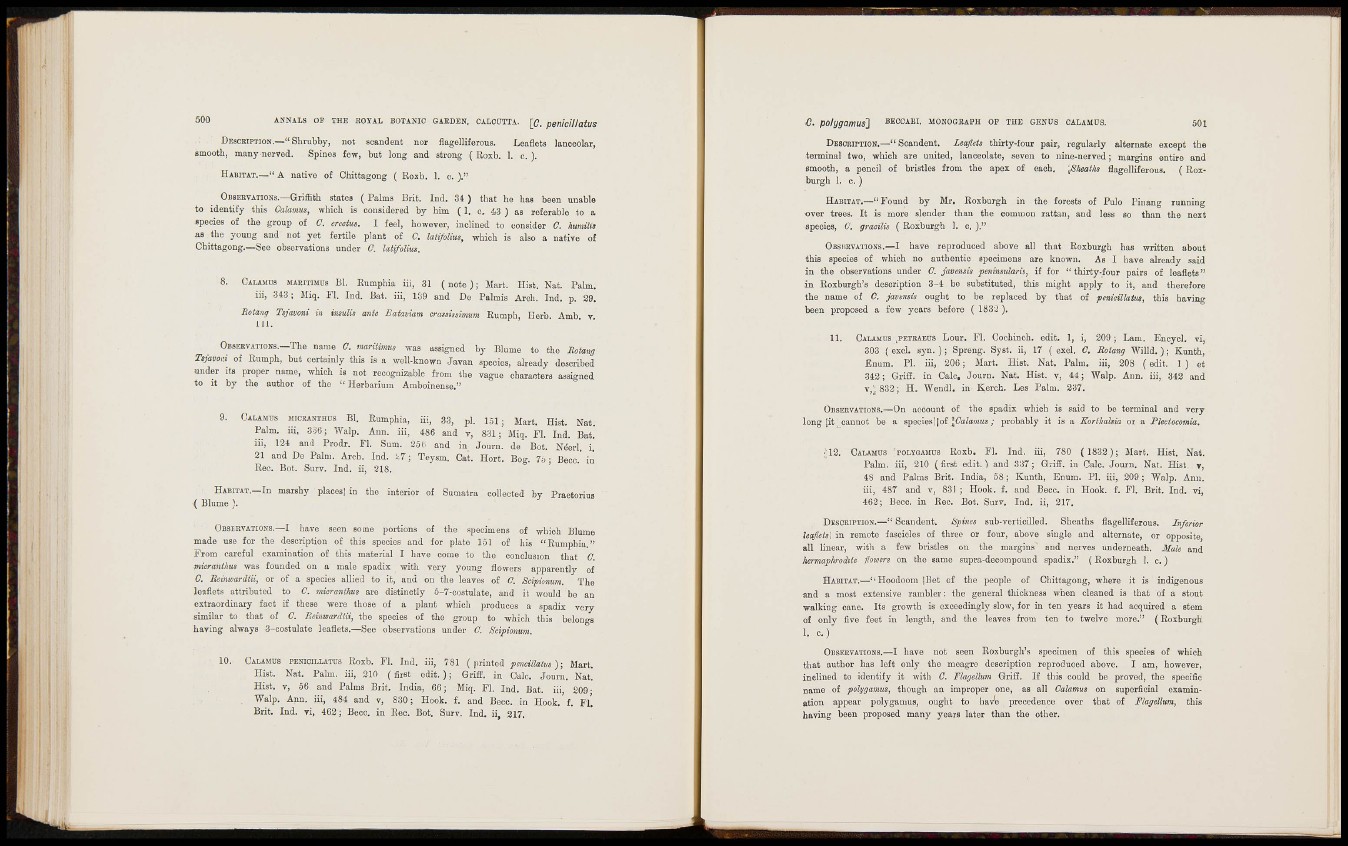
500 ANNALS OP THE EOTAL BOTANIC GAEDEN. CALCUTTA. penicillatus
DESCRIPTION.—" Shrubby, not seandent nor flagelliferous. Leaflets lanceolar,
smooth, many.nerved. Spines few, but long and strong ( Eoxb. 1. c. ).
HABITAT.—" A native of Chittagong ( Roxb. 1. c. )."
OBSERVATIONS.—Griffith states ( Palms Brit. Ind, 34 ) that he has been unable
to identify this Calamus, which is considered by him ( 1. c, 43 ) as referable to a
species of the group of 0. eraius. I feel, however, inclined to consider 0. humilii
as the young and not yet fertile plant of C. lali/dki, which is also a native of
Chittagong.—See observations iiuder 0. laii/oUus.
8. CALAMUS MAMTIUDS B1. Rnmphia iii, 31 ( n o t e ) ; Mart. Hist. Nat. Pahn.
iii, 343 ; Miq. Fl. Ind. iiat. iii, 1S9 and De Palmis Arch. lud. p. 29.
Botany Tsjavoiii in imuUs ante Baiaviam crassiuimnm Rumnh, Herb Amb V
111.
OBSERVATIONS.—The name C. mariiimm was assigned by Blume to the Rotang
T,javKi of Knmph, but certainly this is a well-known Javan species, already described
under its proper name, which is not recognizable from the vague characters assigned
to It by the author of the "Herbarium Amboinense."
9. CALAMHS MICRANTHES B1. Eumphia, iii, 33, pi. lol ; Mart. Hist. Nat.
Palm, iii, 3.36; Walp. Ann. iii, 486 and v, 831; Miq. Tl. Ind. Bat.
iii, 124 and Prodr. PI. Snm. 35 (• and in Joarn. de Bot. N&rl. i.
21 and De Palm. Arch. Ind. Teysm. Cat. Hcrt. Bog. To - Becc' in
Eec. Bot. S«rv. Ind. ii, SIS.
HABITAT.—In marshy places] in the interior of Sumatra collected by Pi-actorias
(Blu
OBSEEVATIOKS.—I have seen some portions of the specimens of which Blame
made use for the description of this species and for plate 151 of his "Rnmphia."
Prom cai-eful examination of this material I have come to the conclusion that C
micrantlms was founded OQ a male spadix with very young flowers apparently of
C. Reinwardiii, or of a species allied to it, and on the loaves of O. Scipionum. The
leaflets attributed to C. micranthus are distinctly 5—7-c<)stuIate, and it would be an
extraordinary fact if these were those of a plant which ijroduees a spadix very
similar to that of C. lieinwardtii, the species of the group to which this belongs
having always 3-costuIate leaflets.—See observations under C. Scipionum.
10. CALAMUS PEiaciLLATUS Roxb. Fl. Ind. in, 781 (printed pemilhlus ); Mart.
Hist. Nat. Palm, iii, 210 (first edit.); Grifi. in Calc. Joum. Nat.
Hist. V, 36 and Palms Brit. India, 66; Miq. M. Ind. Bat. iii 209-
Walp. Ann. iii, 484 and v, 830; Hook. f. and Bocc. in Hook.'f. Fi.
Brit. Ind. vi, 462; Becc. in Eec. Bot. Surv. Ind. ii, 217.
C. po/ygamus) BECCARI. MONOGÄAPH OF THE GENUS CALAMUS. 5 0 1
DSSCRIPTION.—" Seandent. Zeqflcis thirty-ioui pair, regularly alternate except the
terminal two, which are united, lanceolate, seven to nine-nerved; margins entire and
smooth, a pencil of bristles from the apex of each. ^S/^eaí/ia flagelliferous. (Roxburgh
1. c. )
HABITAT.—"Found by Mr. Roxburgh in the forests of Pulo Pinang running
over trees. It is more slender than the common rattan, and less so than the next
species, C. gracilis ( Roxburgh 1. c. )."
OflSiiEVATiONS.—I have reproduced above all that Roxburgh has written about
this species of which no authentic specimens are known. As I have already said
in the observations under C. javensis peninsulam, if for "thirty-four pairs of leaflets"
in Roxburgh's description 3-4 be substituted, this might apply to it, and therefore
the came of C. javmsis ought to be replaced by that of penioillatm, tbis having
been proposed a few years before ( 1832 ).
CALAMUS .PETRAEOS Lour. Fl. Cochinch. edit. 1, i, 209 ; Lam. Encycl. vi,
303 ( excL syn. ) ; Spreng. Syst. ii, 17 ( exel. G. Rotang Willd. ) ; Kunth,
Enum. PI. iii, 206; Mart. Hist. Nat. Palm, iii, 208 (edit. 1 ) et
342; Griff, in Calc. Joarn. Nat. Hist, v, 44; Walp. Ann. iii, 342 and
v,^ 832; H. Wendl. in Kerch. Les Palm. 237.
OBSEEVATIOSS.—On accouut of the spadix which is saii
g [it _cannot be a speciesljof'Ca^awaa ; probably it is a .
to be terminal and very
'orthalsia or a Pleciocomia.
;12. CALAMUS 'POLYGAMUS Roxb. Fl. Ind. iii, 780 ( 1832); Mart. Hist. Nat.
Palm, iii, 210 (first edit.") and 337; Griff, in Calc. Journ. Nat. Hist, v,
48 and Palms Brit. India, 58; Kunth, Enum. PI. iii, 209; Walp, Ann.
iii, 487 and v, 831 ; Hook. f. and Becc. in Hook. f. Fl. Brit. Ind. vi,
462; Becc. in Rec. Bot. Surv. Ind. ii, 217.
DESCRIPTION.—"Seandent. Spines sub-verticilled. Sheaths flagelliferous. Inferior
leaflets', in remote fascicles of three or four, above single and alternate, or opposite,
all linear, with a few bristles on the margins and nerves underneath. Male and
]iermaj>hrod%ie ilowers on the same supra-decouipound spadix." (Roxburgh 1. c.}
HABITAT.—"Hoodoom ¡Bet of the people of Chittagong, where it is indigenous
and a most extensive rambler: the general thickness when cleaned is that of a stout
walking cane. Its growth is exceedingly slow, for in ten years it had acquired a stem
of onlv five feet in length, and the leaves from ten to twelve more." (Roxburgh
1. c . )'
OBSERVATIONS.—I have not seen Roxburgh's specimen of this species of which
that author lias left only the meagre description reproduced above. I am, however,
inclined to identify it with C. Fiagellum Griff, If this could be proved, the specific
name of polygamus, though an improper one, as all Calamus on superficial examination
appear polygamus, ought to bav'e precedence over that of Flagellum, this
having been proposed many years later than the other.